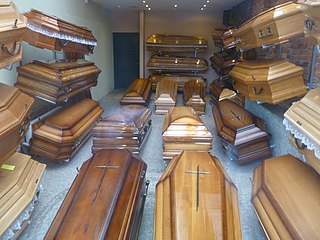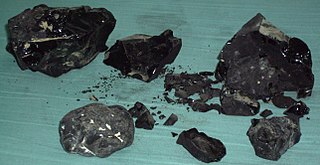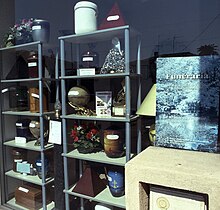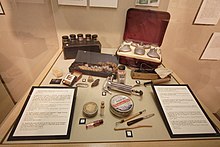
A funeral is a ceremony connected with the final disposition of a corpse, such as a burial or cremation, with the attendant observances. Funerary customs comprise the complex of beliefs and practices used by a culture to remember and respect the dead, from interment, to various monuments, prayers, and rituals undertaken in their honour. Customs vary between cultures and religious groups. Funerals have both normative and legal components. Common secular motivations for funerals include mourning the deceased, celebrating their life, and offering support and sympathy to the bereaved; additionally, funerals may have religious aspects that are intended to help the soul of the deceased reach the afterlife, resurrection or reincarnation.

A mummy is a dead human or an animal whose soft tissues and organs have been preserved by either intentional or accidental exposure to chemicals, extreme cold, very low humidity, or lack of air, so that the recovered body does not decay further if kept in cool and dry conditions. Some authorities restrict the use of the term to bodies deliberately embalmed with chemicals, but the use of the word to cover accidentally desiccated bodies goes back to at least the early 17th century.

A funeral home, funeral parlor or mortuary, is a business that provides burial and funeral services for the dead and their families. These services may include a prepared wake and funeral, and the provision of a chapel for the funeral.

Burial, also known as interment or inhumation, is a method of final disposition whereby a dead body is placed into the ground, sometimes with objects. This is usually accomplished by excavating a pit or trench, placing the deceased and objects in it, and covering it over. A funeral is a ceremony that accompanies the final disposition. Evidence suggests that some archaic and early modern humans buried their dead. Burial is often seen as indicating respect for the dead. It has been used to prevent the odor of decay, to give family members closure and prevent them from witnessing the decomposition of their loved ones, and in many cultures it has been seen as a necessary step for the deceased to enter the afterlife or to give back to the cycle of life.

A coffin is a funerary box used for viewing or keeping a corpse, either for burial or cremation.
Embalming is the art and science of preserving human remains by treating them to forestall decomposition. This is usually done to make the deceased suitable for viewing as part of the funeral ceremony or keep them preserved for medical purposes in an anatomical laboratory. The three goals of embalming are sanitization, presentation, and preservation, with restoration being an important additional factor in some instances. Performed successfully, embalming can help preserve the body for many years. Embalming has a very long and cross-cultural history, with many cultures giving the embalming processes religious meaning.

A bier is a stand on which a corpse, coffin, or casket containing a corpse is placed to lie in state or to be carried to the grave.

The ancient Egyptians had an elaborate set of funerary practices that they believed were necessary to ensure their immortality after death. These rituals included mummifying the body, casting magic spells, and burials with specific grave goods thought to be needed in the afterlife.
Disposal of human corpses, also called final disposition, is the practice and process of dealing with the remains of a deceased human being. Disposal methods may need to account for the fact that soft tissue will decompose relatively rapidly, while the skeleton will remain intact for thousands of years under certain conditions.

In death customs, a viewing is the time that family and friends come to see the deceased before the funeral, once the body has been prepared by a funeral home. It is generally recommended that a body first be embalmed to create the best possible presentation of the deceased. A viewing may take place at the funeral parlor, in a family home or at a place of worship, such as a church. Some cultures, such as the Māori of New Zealand, often take the body to the marae or tribal community hall.

Natural burial is the interment of the body of a dead person in the soil in a manner that does not inhibit decomposition but allows the body to be naturally recycled. It is an alternative to typical contemporary Western burial methods and modern funerary customs.

Mummia, mumia, or originally mummy referred to several different preparations in the history of medicine, from "mineral pitch" to "powdered human mummies". It originated from Arabic mūmiyā "a type of resinous bitumen found in Western Asia and used curatively" in traditional Islamic medicine, which was translated as pissasphaltus in ancient Greek medicine. In medieval European medicine, mūmiyā "bitumen" was transliterated into Latin as mumia meaning both "a bituminous medicine from Persia" and "mummy". Merchants in apothecaries dispensed expensive mummia bitumen, which was thought to be an effective cure-all for many ailments. It was also used as an aphrodisiac.
Mortuary science is the study of deceased bodies through mortuary work. The term is most often applied to a college curriculum in the United States that prepares a student for a career as a mortician or funeral director. Many also study embalming to supplement their mortuary science studies. Some states require funeral directors to be embalmers as well.
The death care industry in the United States includes companies and organizations that provide services related to death: funerals, cremation or burial, and memorials. This includes for example funeral homes, coffins, crematoria, cemeteries, and headstones. The death care industry within the U.S. consists mainly of small businesses, although there has been considerable consolidation over time.
Neglect is defined as giving little attention to or to leave undone or unattended to, especially through carelessness. Mortuary neglect can comprise many things, such as bodies being stolen from the morgue, or bodies being mixed up and the wrong one was buried. When a mortuary fails to preserve a body correctly, it could also be considered neglect because of the consequences.
The Funeral Rule, enacted by the Federal Trade Commission on April 30, 1984, and amended effective 1994, was designed to protect consumers by requiring that they receive adequate information concerning the goods and services they may purchase from a funeral provider.

Caitlin Marie Doughty is an American mortician, author, blogger, YouTube personality, and advocate for death acceptance and the reform of Western funeral industry practices. She is the owner of Clarity Funerals and Cremation of Los Angeles, creator of the Web series Ask a Mortician, founder of The Order of the Good Death, and author of three bestselling books, Smoke Gets in Your Eyes & Other Lessons from the Crematory (2014), From Here to Eternity; Traveling the World to Find the Good Death (2017), and Will My Cat Eat My Eyeballs?: Big Questions from Tiny Mortals About Death (2019).
Women have had varying roles in the death care industry in the United States since its mid-nineteenth century inception.
James E. Reveley was an American mortician, dentist, and consumer advocate for the regulation of the American funeral industry. Through the 1970s, he helped push the Texas Legislature to overhaul the funeral industry's oversight body, eliminate antiquated laws requiring embalming, and pass ground-breaking legislation to protect grieving consumers from exploitative practices. Following his success in Texas, Reveley continued his fight at the national level helping the Federal Trade Commission's Funeral Rule overcome industry opposition and survive congressional veto, transforming the way the funeral industry operates nationwide.













